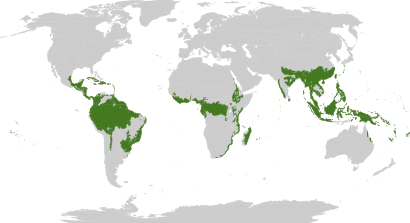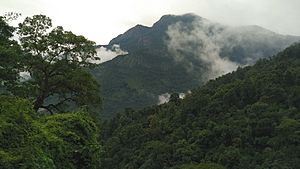Tropical and subtropical moist broadleaf forests facts for kids
Tropical and subtropical moist broadleaf forests (often called TSMF or tropical moist forests) are a special type of forest habitat. The World Wide Fund for Nature (WWF) uses this name to describe these amazing places. They are found in warm, wet parts of the world, close to the equator.
Contents
What Are Tropical Moist Forests?

These forests are usually found in big, spread-out areas near the equator. This is the imaginary line that goes around the middle of the Earth. They are located between the Tropic of Cancer and the Tropic of Capricorn.
Tropical moist forests have a very stable climate. The temperature doesn't change much throughout the year. They also get a lot of rain, usually more than 200 centimeters (about 80 inches) every year.
Most of the trees in these forests are either evergreen (they keep their leaves all year) or semi-deciduous (they lose some leaves, but not all at once). There are thousands of different kinds of trees here. This makes these forests home to more types of living things than almost any other place on Earth!
The highest number of different species lives in the forest canopy. The canopy is like the "roof" of the forest, made by the tree branches and leaves. It has different layers:
- The overstory has very tall trees that stick out above the rest.
- A medium layer of canopy below them.
- A lower canopy layer.
- The shrub level with smaller plants.
- The understory on the forest floor.
These forests are home to more species than any other land ecosystem. About half of all the world's species might live here. In just one square kilometer (about half a square mile), you could find over 1,000 different tree species! You can find these forests all over the world. Big areas are in the Amazon Basin in South America, the Congo Basin in Africa, and the Indo-Malayan Archipelago in Asia.
The warm, wet weather makes these forests grow incredibly fast. A tree can grow over 23 meters (75 feet) tall in just 5 years! From above, the forest looks like a huge green blanket. Only a few very tall "emergent" trees stick out. These tall trees are where birds like hornbills, toucans, and the powerful harpy eagle live.
Many animals live in the canopy, including apes and monkeys. Below the canopy, in the lower understory, you might find snakes and big cats. The forest floor doesn't have much undergrowth because the thick canopy blocks the sunlight. Animals like gorillas and deer roam here.
All parts of these forests have an amazing variety of invertebrates. These include New Guinea’s stick insects and butterflies that can grow over 30 centimeters (1 foot) long!
Sadly, many of these forests are being cut down. People clear them for farmland or for logging. An area the size of Ireland is destroyed every few years.
Different Kinds of Tropical Forests
The tropical moist forest biome includes several different types of forests:
- Lowland equatorial evergreen rain forests are also known as tropical rainforests. They get a lot of rain all year, usually more than 2000 mm (80 inches) annually. These forests are found in a belt around the equator. The largest areas are in the Amazon basin (South America), the Congo basin (central Africa), and parts of the Malay Archipelago. About half of the world's tropical rainforests are in Brazil and Peru. Today, rainforests cover less than 6% of Earth's land. Scientists believe over half of all plant and animal species live in them.
- Tropical seasonal forests are also called moist deciduous or monsoon forests. They have a wet summer season and often a cooler, drier winter. Some trees in these forests drop some or all of their leaves during the dry winter. You can find these forests in South Florida, parts of South America, Central America, the Caribbean, coastal West Africa, parts of India, Northern Australia, and much of Indochina.
- Montane rain forests grow in cooler, mountainous areas. If they are high enough to be often covered by clouds, they are called cloud forests.
- Flooded forests are areas that are regularly underwater. This includes freshwater swamp forests and peat swamp forests.
- Manigua is a type of dense, tangled forest with shrubs and small trees. It's often found in marshy areas, but sometimes on dry land. This term is used in places like Cuba, the Dominican Republic, Puerto Rico, and Colombia.
Where Are These Forests Found?
Many TSMF areas are famous for having many different species and unique plants and animals found nowhere else. Some notable examples include:
- Southwest Amazon moist forests in Brazil, Peru, and Bolivia
- Atlantic Forest in Brazil, Argentina, and Paraguay
- Chocó–Darién moist forests in Colombia and Panama
- The Wet Tropics of Queensland in Australia
- Northwestern Andean montane forests of Colombia and Ecuador
- Guayanan Highlands moist forests
- Cuban moist forests
- Veracruz moist forests in Mexico
- Congolese rainforests
- Upper Guinean forests
- Albertine Rift montane forests from Uganda to Burundi
- Eastern Arc forests of Kenya and Tanzania
- Coastal forests of eastern Africa from Somalia to Mozambique
- Madagascar subhumid forests
- Puerto Rican moist forests
- Sri Lanka lowland rain forests
- Peninsular Malaysian peat swamp forests
- Borneo peat swamp forests
- New Caledonia rain forests
- Western Ghats
See also
 In Spanish: Pluvisilva para niños
In Spanish: Pluvisilva para niños
- Tropical dry broadleaf forest
- Tropical coniferous forests
- Center for Tropical Forest Science (CTFS)
- International Tropical Timber Organization (ITTO)
- List of tropical and subtropical moist broadleaf forests ecoregions
- Monodominance
- Trees of the world
- Tropical vegetation
- Cloud forest




